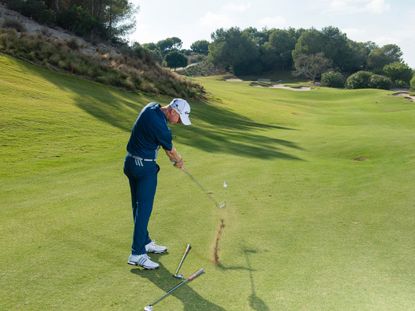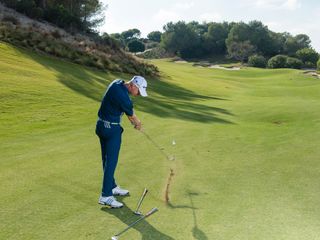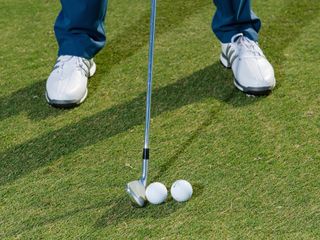Think Football Free Kick To Hit The Draw in Golf
GM Top 25 Coach, Ged Walters, advises thinking about a curling football free kick with the instep to get the feeling and mechanics of the draw in golf


GM Top 25 Coach, Ged Walters, advises thinking about a curling football free kick with the instep to get the feeling and mechanics of the draw in golf
Think Football Free Kick To Hit The Draw in Golf
Checklist * Think about David Beckham’s famous curling free kick! * Right index finger must ‘win the race’ through impact * Put the ball a fraction back in your stance
1) A draw not a hook The draw in golf moves from right to left, but it’s got to be under control - when it’s out of control it becomes a destructive hook. You want the ball to start right of target and finish on target – if it finishes left of target, that's a hook, whether it’s 10ft, 20ft, 30ft or 50 yards left. A successful draw must finish on target.
Watch: GM Top 25 coach Andrew Reynolds explains the hook shot's causes and cures
2) Bend it like Beckham The first thing to do is align the body a little bit to the right, then it’s about the correct movement through the ball. To help, I want you to think about David Beckham’s famous free against Greece back in 2001 that helped England qualify for the World Cup.
Think about how he took that free kick it – he moved his leg and foot to the right, which is the swing direction we need from the golf club, and made contact with the inside of the foot, which was pointing towards the target as he swung his foot out to the right.
Get the Golf Monthly Newsletter
Subscribe to the Golf Monthly newsletter to stay up to date with all the latest tour news, equipment news, reviews, head-to-heads and buyer’s guides from our team of experienced experts.

The ball flew up and over the wall, curled away left and into the top corner – exactly the same mechanics as hitting a draw in golf
Watch: Tour pro Andy Sullivan explains how to hit a draw and add yards to your game
3) Index finger wins A good way to demonstrate what the clubface needs to do through impact is to hold the club in just your lower hand. You’ll see that the lower hand correlates closely to the clubface. Now slide the club into the palm of the hand – if you want to close the clubface you need to get your index finger to ‘win the race’ through impact to create the desired draw spin.

If the base of the hand wins the race and comes in too soon, the ball will head right with a push fade or push slice. If the index finger wins the race, the clubface will be closed to your path through the ball – just what you need.
Watch: GM Top 25 Coach Barney Puttick shares his thoughts on how to hit a draw
4) Ball back a touch You want to strike the ball a fraction earlier in your swing arc too, so put the ball a fraction further back in your stance – not a huge amount, maybe a roll of the golf ball from its normal position. This will help you to hit the ball a touch earlier and create the draw spin.

Then it’s all about tempo. Getting too fast with your body or arms will result in the relationship between face and path getting out of sync, making it hard to generate a consistent draw. Focus on keeping your arms swinging smoothly as your body turns.

Location: Bath GC
Russell has an incredible CV with his students having notched up wins in the Spanish, French, Dutch, Scottish and English Amateur Championships and St Andrews Links Trophy. In 2021 he was awarded the PGA Specialist Coach and Professional he has been the Somerset head coach since 2013. He can also boast to having eight consecutive years with a pupil in the England Men's squad.
A typical lesson:
All sessions are at least 60 minutes and no tuition will happen until the pupil is fully warmed up. Hardware information is gathered along with video while questioning the client on both their practice habits and performances since the last session. When we are both on the same wavelength, we will move forward to diagnosing any problems they may be seeing and set to work on educating them on the best way forward.
I will always question them on their understanding of what they have heard and how they interpret that information. Then we move onto dedicated practice patterns and how to practise are discussed and managed into their notes for after the session. The final stage is to clarify the amount of time before the next session and, if at all possible, book it in there and then. Notes will then follow after the session via WhatsApp, sequentially in order of importance, quantity and how did look for feedback (whether that be positive or negative).
Students learn best when…
They understand the process and the content being delivered. There is nothing more disconcerting than 'frown lines'. If I see them, I pounce and ask questions to probe why they frowned or showed confusion in the instruction/knowledge given. I cannot move beyond that stage without knowing they are clear in the next steps to be taken. Whether that be technical, conceptual or strategic.
Describe the greatest teacher you have ever known:
Hugh Marr. For me Hugh is one of the most impactful coaches of my generation and someone who I respect enormously. Unknown to many but hugely respected by the people who know him.
-
 Former NFL Star Tony Romo Reveals 'Insane' Scottie Scheffler Stat After Playing 500 Rounds With World No.1
Former NFL Star Tony Romo Reveals 'Insane' Scottie Scheffler Stat After Playing 500 Rounds With World No.1Tony Romo spoke highly of his good friend Scottie Scheffler, comparing him to Tiger Woods and Jack Nicklaus
By Joel Kulasingham Published
-
 'I Think He'll Be Great' - Paul Azinger Reveals Early Scottie Scheffler Prediction
'I Think He'll Be Great' - Paul Azinger Reveals Early Scottie Scheffler PredictionThe former NBC Sports lead analyst has explained how he saw greatness in Scottie Scheffler years before he began to dominate
By Mike Hall Published